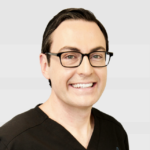The nasal septum is the cartilaginous and bony structure that partitions the nasal cavity into the left and right sides. It plays a crucial role in nasal structure and function, helping to define the tip of the nose and support the middle part of the nose. The septum also contains some sensory tissue involved in smell function. Septoplasty is the surgical modification of the structure of the nasal septum, typically performed to straighten it, repair a fracture, or remove spurs (tissue blocking the nasal passage). A hole in the septum (“perforation”) can result from external nasal trauma – even when the nose is not broken. This happens when a patient develops a septal hematoma (collection of blood within the septum). If left untreated, this may result in perforation or collapse of the middle part of the nose (saddle nose deformity), which can cause lifelong issues with nasal structure and function. Any suspicion of septal hematoma requires urgent medical attention. In other cases, prior surgical intervention (e.g., septoplasty, rhinoplasty, or other nasal and sinus procedures) may be complicated by delayed development of a septal perforation. Finally, use of nasally inhaled medications and certain illicit drugs may result in chronic tissue damage and subsequent perforation.
Septal perforations can cause a sensation of nasal obstruction, chronic nosebleeds (epistaxis), recurrent infections or crusting, and an audible sound during normal breathing. Surgical repair can be challenging, but Dr. Ransom uses a special method with a very high success rate. In order to fill in the hole in the septum and to promote healing of the surrounding nasal tissue, Dr. Ransom uses a multi-layered repair. This includes a layer of your own connective tissue (fascia) for each side of the septum, as well as a central layer that is more rigid. For this essential structural element, Dr. Ransom uses the PDS flexible plate (Ethicon). This is a thin sheet of polydioxanone, a material used in long-acting dissolvable sutures, that is customizable in shape and size. The repair can be completed via an open or closed (endonasal) approach, depending on the size and location of the perforation and any other planned surgery (e.g., cosmetic or revision rhinoplasty).
As a nose specialist, Dr. Ransom offers his patients a unique ability to address both the internal and external parts of the nose. Functional rhinoplasty, however, is not a cosmetic surgery, and should not be treated as such. Cosmetic changes to the nose may be combined with functional surgery or septal perforation repair for a more comprehensive approach. We are dedicated to working with you to create a plan that addresses all of your aesthetic and breathing concerns.
Am I a candidate?
Patients with a septal perforation may be a candidate for repair. In rare cases, a perforation may be too large to be repaired as described here. Dr. Ransom will assess your nasal structure and function during your consultation and is happy to discuss the details of all types of nasal surgery.
Frequently Asked Questions
In many cases, your insurance will cover functional changes to the nose to improve breathing, fix a fracture, or reconstruct a damaged portion of the nose. Insurance does not pay for cosmetic changes, though this can be added to functional surgery. Dr. Ransom does not accept insurance to cover complications of prior cosmetic surgery. Dr. Ransom is in-network with most major PPO plans as well as Medicare. We are happy to look into your benefits following your consultation.
No packing is used in the nose, which makes recovery much more comfortable. Septal stents are used bilaterally to protect the repair. These are secured in place for 7 to 10 days and are removed in the office. Your nose may feel congested during this time. Occasional spotting is normal, but any heavy bleeding should be reported to the doctor. Pain is generally limited. You may feel tired for a couple of days after surgery and should limit your activities to concentrate on resting and recovery.
Dr. Evan Ransom is an Ivy League-educated and Ivy League trained Facial Plastic and Reconstructive Surgeon. He is a Double Board Certified Head and Neck Surgeon and Facial Plastic and Reconstructive Surgery and fellowship-trained in facial plastic, reconstructive, and laser surgery. His practice is in the San Francisco Bay Area, serving patients from San Francisco, Oakland, Marin County, Palo Alto, Silicon Valley, Walnut Creek, the East Bay, and all over Northern California.
 (415) 550-1077
(415) 550-1077 San Francisco
San Francisco

